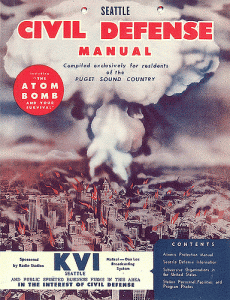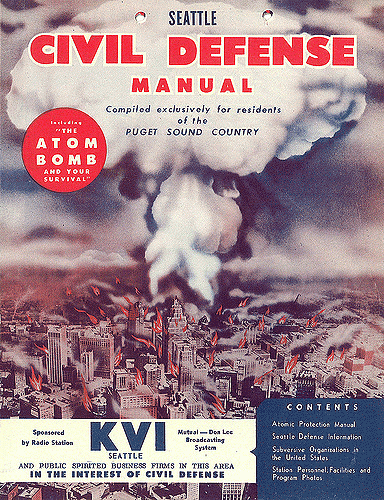 When you think of a nuclear treaty such as New START, a decrease in the number of nuclear weapons naturally comes to mind. While that’s been true in the past, New START leaves the nuclear arsenals of the United States and Russia more or less intact. In March 2010 Hans Kristensen of the Federation of American Scientists explained at it Strategic Security Blog that:
When you think of a nuclear treaty such as New START, a decrease in the number of nuclear weapons naturally comes to mind. While that’s been true in the past, New START leaves the nuclear arsenals of the United States and Russia more or less intact. In March 2010 Hans Kristensen of the Federation of American Scientists explained at it Strategic Security Blog that:
. . . the treaty does not require destruction of a single nuclear warhead and actually permits the United States and Russia to deploy almost the same number of strategic warheads that were permitted by the 2002 Moscow Treaty [thanks to, in part, a] new counting rule that attributes one weapon to each bomber rather than the actual number of weapons assigned to them. [In fact, this] “fake” counting rule frees up a large pool of warhead spaces under the treaty limit that enable each country to deploy many more warheads than would otherwise be the case. . . . Indeed, the New START Treaty is not so much a nuclear reductions treaty as it is a verification and confidence building treaty.
(As well as — anyone familiar with my writing knows — a mechanism by which Republicans squeezed an $85 billion commitment from the Obama administration to shore up the nuclear-industrial complex over the next decade.)
The confidence-building to which Kristensen alluded is an element of the treaty to which many conservatives objected. With nostalgia for the Cold War still running high among them, they bridled at the extent to which New START signified a “reset” in relations with Russia. Thus, with hawks always willing to poke a stick into the hive of U.S.-Russia relations, it’s folly to think that just because the Cold War ended that we’ve been inoculated against nuclear war with Russia. Especially since the chances of an accident are greater than ever, as I explored in a previous post.
Not to worry, though — we can always “ride out” a nuclear attack. Ride-out is one of the president’s two options in the event of a nuclear attack, neither of which is declared policy, though. First, the other: launch-on-warning. In that scenario, as soon as it believes that it has detected nuclear weapons headed towards it soil, a state mounts a retaliatory strike. In another words, the attacked state isn’t waiting around for the decisive confirmation — which detonation on its soil constitutes — that the alarm wasn’t false.
Ride-out is waiting until struck before retaliating, to keep from responding to a false alarm. Besides, to do otherwise would violate the spirit of deterrence, which stands in opposition to a preemptive attack. Of course, you’re wondering if the United States would be in a position to counterattack after the initial nuclear strike on its soil. Not only will our missile silos have been targeted but the nuclear command and control infrastructure.
In a recent paper for the Hudson Institute, Christopher Ford, one of its research fellows, addresses this.
. . . analysts [have] wondered for years whether it was even possible to ensure sufficient nuclear force and C3I [command and control] survivability in the face of the enormous nuclear barrages that were possible at the height of the Cold War. Desmond Ball and John D. Steinbrunner, for instance, argued in the early 1980s that such survivability was, for practical purposes, a fool’s errand. . . . As the Soviets put more and more warheads on their missiles . . . it seemed increasingly likely that no such system would be able to survive a full-scale attack.
Back in 2004, writing for his Center for Defense Information, neither was Bruce Blair too sanguine about riding out a nuclear attack.
The option to “ride out” the onslaught and then take stock of the proper course of action exists only on paper. . . . The bias in favor of launch on electronic warning is so powerful that it would take enormously more presidential will to withhold an attack than to authorize it.
Besides:
Military nuclear commanders designed the hardware and procedures of emergency decision-making to ensure that no president would actually deliberately opt to ride out a Soviet nuclear attack, even though U.S. nuclear policy [as stated above — RW] endorsed second-strike retaliation – assured destruction – as the essential element of U.S. deterrent strategy. . . . They knew full well that the U.S. nuclear command system would collapse under the weight of such a Soviet first strike. . . . Riding out was not a practical choice in the real world, and so the operational system was geared so that presidential approval to unleash U.S. strategic forces before the first incoming Soviet missile reached America would be obtained.
But, in “today’s post-Cold War context,” writes Ford, C3I “survivability may be less Quixotic an aspiration.” In other words, despite the incremental progress that New START represents, the number of nuclear weapons may now be low enough to enable us to ride out an attack. “It may now be possible,” he explains, “for both sides to develop a credible ‘ride-out’ option – arguably for the first time in decades . . . simultaneously ensuring retaliation and reducing incentives to implement launch on warning.”
The term “ride-out” implies a mutual decision about how many casualties are acceptable. Needless to say, no such consensus exists. One man’s survival is another’s “the living will envy the dead.”
More from Ford: “Domestic U.S. civil defense preparations were . . . discontinued” at the height of the Cold War when arsenals were at their largest. The “Kennedy Administration had proposed an extensive civil defense program in 1961, but it soon became clear that most defensive measures could be far more easily and cheaply neutralized by the enemy than created in the first place.”
Recently however, the Obama administration has revived the subject of surviving a nuclear attack if you’re not at ground zero. On December 15, William Broad wrote in the New York Times:
The government has a surprising new message: Do not flee. Get inside any stable building and don’t come out till officials say it’s safe. The advice is based on recent scientific analyses showing that a nuclear attack is much more survivable if you immediately shield yourself from the lethal radiation that follows a blast, a simple tactic seen as saving hundreds of thousands of lives. . . .
Administration officials argue that the cold war created an unrealistic sense of fatalism about a terrorist nuclear attack. “It’s more survivable than most people think,” said an official.
That’s if you hold to the prevailing doctrine that terrorists, not a nuclear state (the question of a state arming the terrorists aside), would be the likely source of an attack. The attack would presumably be a fraction of that mounted by a state such as Russia.
Whatever the case, the new emphasis on nuclear survival doesn’t sit well with many. In an article for the Atlantic titled The Unexpected Return of Duck and Cover, Glenn Reynolds writes:
But now “duck and cover” is back, not as kitsch but once again as serious advice from the federal government. Faced with growing concerns about a nuclear attack on one or more major cities . . . authorities are once again looking to educate citizens about what to do in the event of a nuclear attack. And that advice sounds a lot like what they were saying in my grandfather’s day: Duck and cover.
False hope, in other words. At Truthout, Ira Chernus also scoffed at the notion.
The Obama administration wants us to learn to accept the prospect of a major American city destroyed. Its report never even mentions the possibility of averting disaster by changing the U.S. policies that enrage people, whether abroad or at home.
In other words, “negotiating with terrorists” frightens Washington even more than a nuclear attack on American soil.

